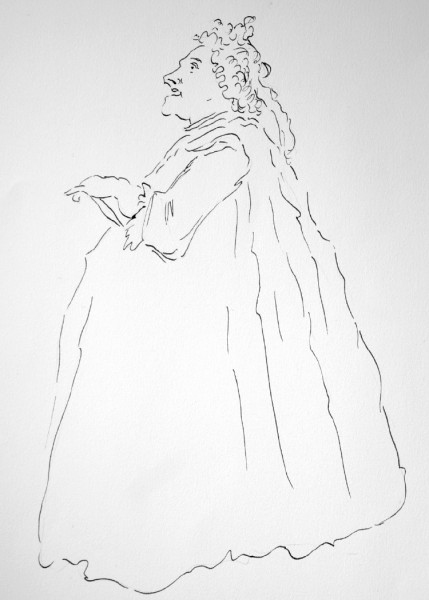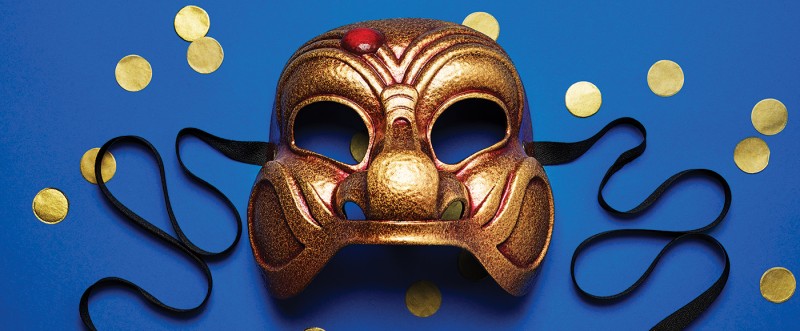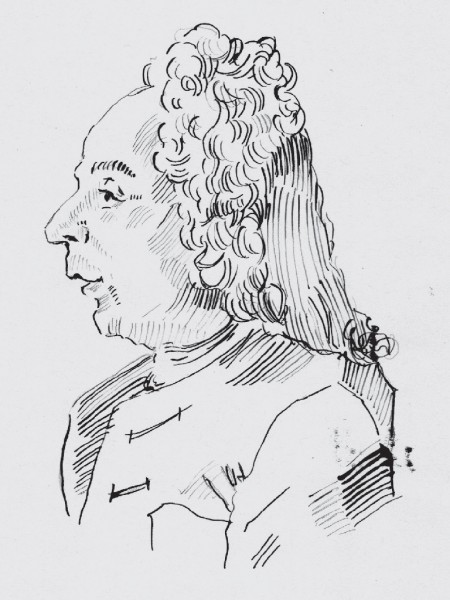Download the Program Notes & Image Credits and Program Listing
Program Notes
by Marco Cera
Good evening, ladies and gentleman — or rather, Buonasera, signori e signore. Welcome to Rome, c.1723. Tonight you have just entered the home of a very fine artist, Pier Leone Ghezzi (1674–1755), for a private musical soirée.
Ghezzi was a painter, caricaturist, amateur musician, and impresario. His enormous legacy of drawings depict Roman society during the Arcadia era, a period of reaction to the excesses of the baroque. A passionate music lover, he held a private concert (or accademia musicale) each week at his palazzo, inviting prominent musicians who were passing through Rome. Famous composers, instrumentalists, and singers (including castrati) attended, hoping to impress the audience with new compositions or displays of musical skill. But what they often received was a new Italian invention, a “caricature.”
During the soirée, Ghezzi would immortalize the event with the baroque equivalent of an Instagram post: armed with ink and paper, he would draw a portrait of the performer(s). In doing so, he gave us rich details about their hairstyles, dress, posture, instruments, and even the furniture in the salon. Sometimes his portraits included satirical comments on the subjects. Without a doubt we can say that Ghezzi was the first professional caricaturist! It was not only musicians who were immortalized in Ghezzi’s caricatures, but also Roman aristocrats, gentlemen undertaking their Grand Tour, artists and connoisseurs, church officials, and intellectuals, all from both Italy and abroad.
Tonight’s recreation of one of these private concerts is animated by music connected to Ghezzi’s life. We begin with the overture to Francesco Gasparini’s L’oracolo del Fato. Gasparini studied in Rome with Pasquini and Corelli, and held the post of organist at the church of Madonna dei Monti from 1682. In 1701 he moved to Venice to work as the maestro di cappella at the famous Ospedale della Pietà. Back in Rome in 1716, Gasparini was admitted to the Accademia dell’Arcadia and became the director of La Cappella di San Giovanni Laterano. It is around this time that Ghezzi drew Gasparini, the two men likely having met during an accademia musicaleat the home of Cardinal Polignac, Ghezzi’s patron and friend. Despite his prolific work as a composer (he wrote 60 operas), Gasparini was also quite active as a teacher: his pupils included Benedetto Marcello, Johann Joachim Quantz, and Domenico Scarlatti — and we should credit him for engaging the services of Antonio Vivaldi at the Ospedale della Pietà in 1703 to teach the violin.
Ghezzi’s portrait of Antonio Vivaldi is the most important, authentic, and realistic image of the Venetian composer. We see his huge curved nose (Gasparini nicknamed Vivaldi " il Naso"in an enigmatic letter to his friend, the castrato Pier Francesco Tosi), dimpled chin, slanted forehead, heart-shaped mouth, and his flaming hair uncovered by a wig.
At the bottom of the drawing Ghezzi wrote: "The Red Priest, composer of music who wrote the opera at the Capranica in 1723." In that year, Vivaldi travelled to Rome to oversee the rehearsals for his melodramma Ercole sul Termodonte, mounted at the Teatro Capranica. Little did he know that this trip would result in his image being immortalized by Ghezzi.It is likely that Sonata RV 6 for violin and continuo is one of several sonatas presented by Vivaldi to the great Roman patron of the arts, Cardinal Ottoboni, during the 1720s. Around this time, Ghezzi (along with his sketchbook) was often invited to attend accademieat Ottoboni’s palazzo.
The popular accademie musicali represented the only opportunity in Rome to hear a professional female singer. An edict introduced by Innocent XI forbade women to appear onstage in theatres or perform in church within the Papal States. This gave the castrati enormous employment opportunities, covering female roles in the theatre and the upper parts in church music.

The second part of our soirée opens with an overture from Leonardo Vinci’s Partenope. Ghezzi’s drawing of Vinci includes this comment: “Signor Vinci from Napoli: died in 1730 but could be buried only thanks to the generosity of the sister of His Eminence Ruffo, since he owned less than three coins. He was a valiant musician who could compose with spirit, but he was a man who would gamble his own eyes.”
Ghezzi’s comments were not always so colourful. Below his portrait of Giovanni Bononcini he simply wrote “Signor Giovanni Bononcini, famoso sonator di violoncello e compositore di musica.” Bononcini was indeed very famous all around Europe, both for his fine compositions as well as his virtuosity on the cello. He came from a large family of musicians and studied with his father, Giovanni Maria. His rivalry with Handel and their backing by opposing political and social factions was recorded in John Byrom’s satirical piece, On the Feud Between Handel and Bononcini. Ghezzi met Bononcini in Rome around 1720. He portrays the famous composer in elegant dress and a fashionable wig, with a sword and a tricorn under the arm. His right hand is in the gesture of conducting.
We conclude our evening with the music of Giovanni Battista Pergolesi: an exquisite aria for soprano with oboe obbligato, as well as the overture from Adriano in Siria. Ghezzi wrote in his memoirs: “In May of 1734, Pergolesi traveled from Naples to Rome in order to supervise his composition commissioned by the Duke of Matalona. The music was full of spirit and extraordinarily lively!”
In his memoirs, Ghezzi often talks about his servant, a roguish man always ready to rob him (though not without consequences): he seems truly a stock character out of the commedia dell’arte. One wonders if Ghezzi’s stories about his “Harlequin” might have inspired Carlo Goldoni’s The Servant of Two Masters(1743):
“Harlequin! What will you pull out of your sleeve tonight? Are you going to spoil our concert? Are you going to trash our Roman salon?”
Follow the development of The Harlequin Salon through a series of insightful blog posts, following creator Marco Cera and exploring the characters involved. READ MORE
PROGRAM LISTING
Conceived, programmed and scripted by Marco Cera
Directed by Elisa Citterio
Roberta Invernizzi soprano
Dino Gonçalves actor
January 16–20, 2019
Jeanne Lamon Hall, Trinity-St. Paul’s Centre
Image credits:
Antonio Vivaldi, drawn by Marco Cera, after Ghezzi
Faustina Bordoni, drawn by Marco Cera, after Ghezzi
Giovanni Bononcini, drawn by Marco Cera, after Ghezzi



